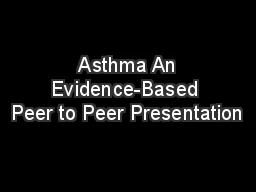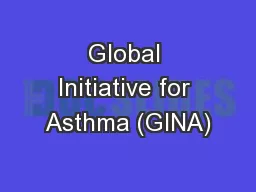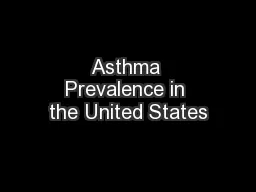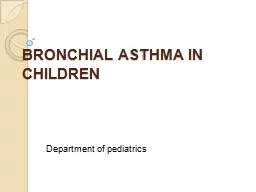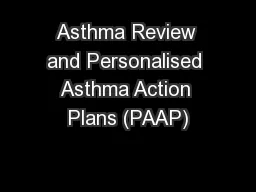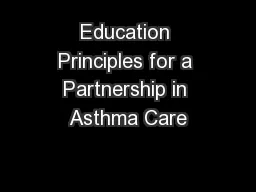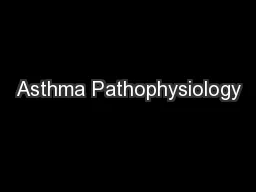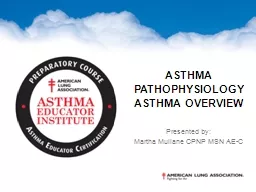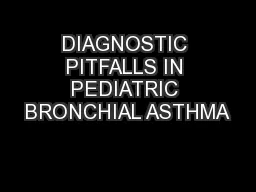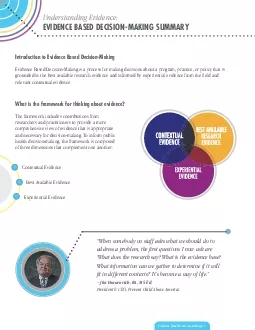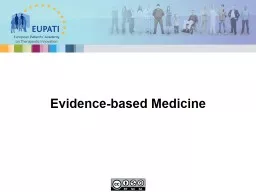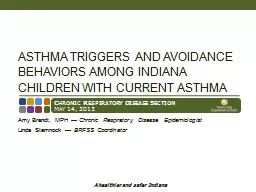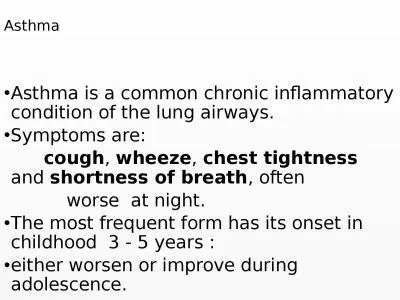PPT-Asthma An Evidence-Based Peer to Peer Presentation
Author : conchita-marotz | Published Date : 2020-04-03
Erin HallRhoades MD Ithaca College PhysicianAssistant Medical Director Why this talk My partner is one of the many organizers for this conference I was humbled
Presentation Embed Code
Download Presentation
Download Presentation The PPT/PDF document " Asthma An Evidence-Based Peer to Peer P..." is the property of its rightful owner. Permission is granted to download and print the materials on this website for personal, non-commercial use only, and to display it on your personal computer provided you do not modify the materials and that you retain all copyright notices contained in the materials. By downloading content from our website, you accept the terms of this agreement.
Asthma An Evidence-Based Peer to Peer Presentation: Transcript
Erin HallRhoades MD Ithaca College PhysicianAssistant Medical Director Why this talk My partner is one of the many organizers for this conference I was humbled when doing a selfassessment module for my family medicine boards last year. During an asthma attack airways become inamed making it hard to breathe Asthma attacks can be mild moderate or serious and even life threatening Symptoms of an asthma attack include Coughing Shortness of breath or trouble breathing Wheezing Tightne What’s new in GINA 2015?. Add-on . tiotropium. by soft-mist inhaler is a new ‘other controller option’ for Steps 4 and 5, in patients ≥18 years with history of exacerbations. T. iotropium was previously described in GINA as an add-on option on the basis of clinical trial evidence. . National Center for . Environmental Health. Division of Environmental Hazards and Health Effects. June 2014. CDC’s National Asthma Control Program (NACP) was created in 1999 to help the millions of people with asthma in the United States gain control over their disease. The NACP conducts national asthma surveillance and funds states to help . Department of pediatrics. Definition. Asthma. is a chronic . disease . involving the respiratory system in which the . airways . occasionally . constrict, become . inflammated. , . and . are . lined with excessive amounts of . Jane . Setchell. Marilyn Plummer . We are giving good care but we need to improve . Personal Asthma Action Plans (PAAP) in NRAD . Only 4/28 of the children who died had a PAAP. Key Recommendation…. . Learning strategies that contribute to successful asthma management. Presented by . :Christina Perry, PhD. Need for effective patient education. Barriers to learning. Current educational concepts . Allergic disease affects 40 million to 50 million Americans. Nearly 20-25 percent of U.S. population suffers from:. Asthma. Allergic rhinitis. Sinus infections. Eye . allergies. Skin allergies. Food allergies. Asthma Overview. Presented by:. Michelle Harkins, MD. University of New Mexico. This session will cover. Review asthma statistics. Define asthma. Outline key . pathophysiologic. features. Review signs and symptoms of asthma. Asthma Overview. Presented by:. Martha . Mullane. . CPNP . MSN AE-C. This session will cover. Definition asthma. Outline key pathophysiologic features of asthma-early and late phase inflammation and broncho-constriction. Ibrahim . A. . Janahi, MD, FCCP, FRCPCH . Professor of Clinical Pediatrics, Weill Cornell Medicine- Qatar . Division Chief, Pediatric . Pulmomnology. . Learning points . What is asthma/Differential diagnosis of wheezy chest . EVIDENCE BASED DECISION-MAKING SUMMARY147When somebody on staff asks what we should do to 145What does the research say What is the evidence base What information can we gather to determine if it wil ) is . about systematically . reviewing, appraising, and using clinical research findings to aid the delivery of optimum clinical care to patients. . Patient . knowledge of . EBM . is important because it enables them to make more informed decisions about disease management and treatment. . Amy Brandt, MPH — . Chronic Respiratory Disease Epidemiologist. Linda Stemnock — . BRFSS Coordinator. Chronic Respiratory Disease Section. May 14, 2013. Overview. This slide set was presented at the Indiana Statewide Asthma Conference on May 14, 2013. These slides are intended to be a resource for our partners.. the lung airways. . Symptoms . are:. . cough. , . wheeze. , . chest tightness . and . shortness of breath. , . often. worse . at night. . The most frequent form has its onset in childhood .
Download Document
Here is the link to download the presentation.
" Asthma An Evidence-Based Peer to Peer Presentation"The content belongs to its owner. You may download and print it for personal use, without modification, and keep all copyright notices. By downloading, you agree to these terms.
Related Documents

